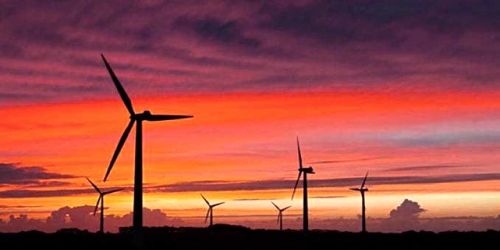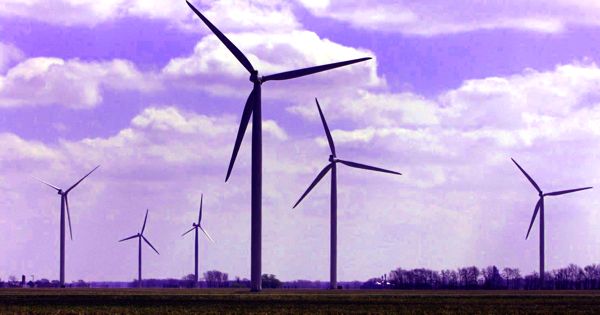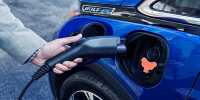Replicate Wind Farm Improvement
Wind turbines operate on a simple principle. Wind turbines are unique devices that are typically anchored to the ground but operate in the atmosphere, which subjects them to a variety of torques and loads as weather conditions change. The energy in the wind turns two or three propeller-like blades around a rotor. The rotor is connected to the main shaft, which spins a generator to create electricity.
Wind farms are large, highly technical projects but their development often relies on personal decisions made by individual landowners and small communities. Modeling this behavior for land-based wind turbines is difficult enough, but the issues become even more complex for floating offshore wind turbines that may respond to such conditions by moving and can be subjected to rolling seas that may affect their performance. Recognizing the power of the human element in wind farm planning, Stanford University researchers have devised a model that considers how interactions between developers and landowners affect the success and cost of wind farms. Researchers have developed a variety of computer modeling and software simulation tools to support the wind industry with state-of-the-art design and analysis capabilities.
“I’ve been doing work on the costs of wind farms for about 10 years and I’ve found that the soft costs — basically the cost interactions between people — are overlooked,” said Erin MacDonald, assistant professor of mechanical engineering at Stanford.
When wind power is generated by wind turbines in a wind farm, the optimal placement of turbines is critical because different layouts produce different efficiencies. The cost analysis suggests that these actions while contributing to upfront costs, may end up saving developers money in the long run. With additional input from real-life landowner acquisition case studies, the researchers hope to further refine this model to ultimately increase the success of project implementation and reduce the cost of overall wind farm development. It enables the analysis of a range of wind turbine configurations, including:
- Two- or three-bladed horizontal-axis rotor
- Pitch or stall regulation
- Rigid or teetering hub
- Upwind or downwind rotor
- Lattice or tubular tower
- Land-based or offshore.

Quantifying interactions
Conventional energy sources such as oil, natural gas, or nuclear are finite and generate pollution. Alternatively, renewable energy sources like wind, solar, tidal, fuel cell, etc are clean and abundantly available in nature. Among those, wind energy has the huge potential of becoming a major source of renewable energy for this modern world. In order to cost-efficiently obtain the wind energy, researchers have considered optimization techniques for the layout of wind turbines in wind farms.
The wind has a power that can be converted into energy (electricity) generated by wind turbines and mechanical power generated by windmills. During the process of planning a wind farm, a developer uses models to predict how much the project will cost versus how much energy it will produce. The purpose of the model is to simulate the dynamical behavior and the electrical properties of a wind turbine. These models are mathematical formulas that map the relationships between different pieces of a project — such as materials, labor, land, and, in this case, interactions between developers and landowners. The Simulator for Wind Farm Applications (SOWFA) employs computational fluid dynamics to allow users to investigate wind turbine and wind power plant performance under a full range of atmospheric conditions and terrain.
In previous work, MacDonald and her former graduate student and postdoctoral fellow, Le Chen, created a model where they integrated landowner decision-making into a wind farm layout optimization model — which otherwise focuses on what physical layout will produce the most energy. The wind turbine model consists of different component models: wind model, aerodynamic model, transmission model, and of the electrical components such as induction generator, soft-starter, capacitor bank, and transformer model.
“This work gives developers a framework to evaluate different actions, whereas right now it’s hard to compare potential impacts of those actions, for example, how investing in landowner relations stacks up against buying more efficient equipment,” said Yiqing Ding, a graduate student in mechanical engineering and co-author of the paper.
The wind farm development tool accepts user-defined parameters such as mean wind speed, turbulent intensity wind farm layout and etc. to develop a wind farm model. To account for soft costs in their model, the researchers had to study and brainstorm different scenarios for the interactions that occur during wind farm development — and their outcomes — and then translate the most crucial details of those interactions into formulas that could integrate with more traditional project analysis models.
“The model suggests that taking preemptive actions can improve landowners’ acceptance but can also incur a cost,” said Ding. “Timing is also important: we found that when an action is taken can influence landowner acceptance.” While some developers conduct community meetings and preliminary environmental studies, sharing a layout plan with landowners is rare.
A co-design process
The demand of renewable energy plays an increasingly important role as fossil fuels become more and more expensive and harder to justify in expenses. The researchers recognize that making the development process more transparent is challenging and adds to initial expenses. However, they are still optimistic about the potential for innovative, collaborative actions that could ultimately improve the success and value of wind power. The objective of the wind turbine placement problem is to maximize the generated power while minimizing the cost of installing the turbines.
For example, MacDonald suggests that virtual reality mockups of turbine plans might increase landowner contract acceptance, given that previous studies have found that people tend to be more accepting of the appearance of turbines once they see them in place.
Other options for increasing transparency and collaboration could include making contracts easier to read and giving landowners some choice, such as two alternatives for how their land could be used. For wind energy, the future lies in developing offshore wind turbines that are capable of harnessing the much higher wind speeds available offshore while avoiding the problem of skyline pollution.
Meanwhile, the proof-of-concept model for landowner acceptance requires continued research and refinement. Wind turbine manufacturers are generally very restrictive on giving out this type of information, and thus typical configurations and parameters have been used in this work. The researchers are hoping to see more studies of soft costs for wind farms in general and would like to gain more insight into developers’ processes — which tend to be proprietary — in order to make the model useful to them. While the global wind sector growth continues at a rapid pace, many wind farms are maturing, resulting in owners and operators scrutinizing operational performance more than ever.
















